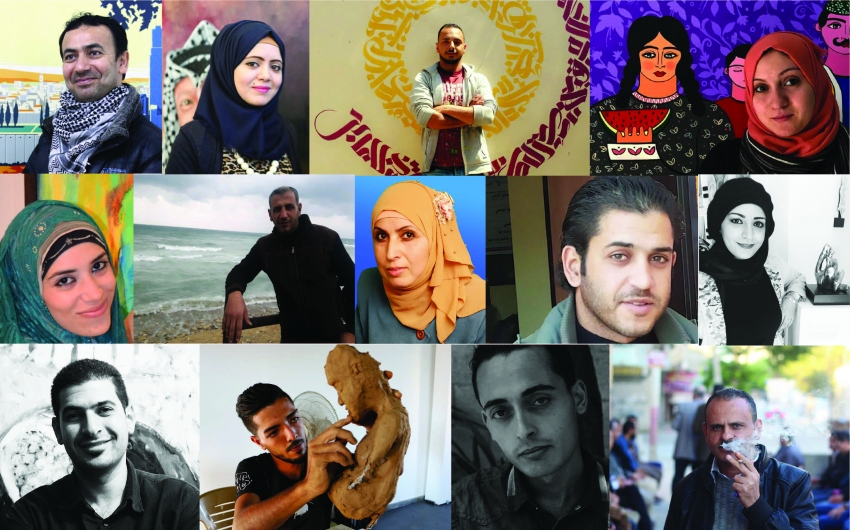
For the first time, in the beginning of October 2018, and within the “Contemporary Linkages” project, thirteen artists from the Gaza Strip were selected to be beneficiaries of production grants and new art residencies. Funded by the “Visual Art: A Flourishing Field” programme, the project targets visual artists in Gaza and is implemented by the artists’ collective Shababeek, which also functions as the artistic department in The General Union of Cultural Centres in Gaza.
These grants aim to provide opportunities for cultural and artistic contemporary productions, allowing artists to utilise multimedia and to showcase their artworks. This also creates opportunities for artists to interact directly with each other and with supervisors residing outside the Gaza Strip, thus deepening and enriching their artistic pathway.
The “Contemporary Linkages” project began with the implementation of a training programme that focused on preliminary conceptual framing and the development of artistic projects through research and experimentation. This has led to the development of coherent artistic proposals, which have been supervised by the curator Ala Younis with the participation of twenty-two artists from the Gaza Strip.
Dua Qishta (27 years old) enrolled in the training programme and developed her project that examined the crises involving mortuary refrigerators occurring during the Israeli attack on the Gaza Strip in 2014, when the bodies of children who were killed had to be kept in ice cream refrigerators in the hospitals because of the high number of casualties.
Through a competition process with dozens of other artists, Qishta later applied for and received a production grant to enable her to implement her project. She chose sculpture and 3D printing as her media. Qishta illustrates that media such as these provide a space for material experimentation and are more representative of the visualisation and the surreal scene she was exploring.
The grants range between $1500–$2000 and enable artists to work for three months on producing new work. They also offer access to a number of books, artistic resources and supervisory support from artists and curators residing outside the Gaza Strip. The participants are also provided with an opportunity to showcase their work through solo exhibitions, as the artist Shareef Sarhan, the artistic director of the “Contemporary Linkages” project has said.
The project also provides the opportunity for six artists to be awarded an art residency in Shababeek. At the beginning of the project in January 2018, the second floor of Shababeek was renovated and divided into studios for artists. Each residency lasts for three months, during which the artist has the space to work and experiment, and is also given a financial grant to cover the period of his/her residency and the cost of materials.
The artist Raed Issa, one of the recipients of the residency, will work on producing new artworks that utilise graphic and printing techniques. Issa was a recipient of the Young Artist of the Year Award in 2002 and is one of the members of the “Eltiqa” artists’ group. His work deals with individual and collective memories of Palestinian displacement and connects it to human stories from the Return protests on the Palestinian borders. This new project of Issa’s is distinguished by the use of new printing techniques.
As Issa said: “this is the first time that funded art residencies in this form have occurred in the Gaza Strip. It is an important opportunity for artists as it provides a free environment for work. The space that is provided is suitable for large size paintings and is logistically equipped with electricity and internet services, which are often not available in the Gaza Strip.”
The form of these art residencies was inspired by some of the artists’ experience of residencies in the Cité Internationale des Arts in Paris, where Shareef Sarhan, for example, was previously an artist-in-residence. Sarhan explains that the programme will include biweekly meetings for exchanging expertise with artists, curators and performers from both inside and outside Palestine. In addition to a studio that will open once a month to introduce and discuss the artists’ projects with the audience, at the end of each stage of the residencies, which are divided into two stages, the results of the artists’ experience will be exhibited in a group exhibition.
The programme seeks to create a paradigm shift in art production in the Gaza Strip. It will provide the artists who are awarded the grants and residencies the opportunity to work under the supervision of prominent Arab and international artists and curators, including Ala Younis, Salah Sauli, Mohamed Haja, Serwan Baran, Majed Shala and Hazem harb.
Sixty artists from Gaza applied for the production grants and residencies. The proposals were evaluated by a committee composed of specialised members in visual art and performance, including: Taysir Batniji, an artist based in Paris; Hossam Al Madhoun, an actor and theatre director based in Gaza; and Raeda Saadeh, an artist based in Jerusalem.
Saadeh believes that artists in Gaza are eager for artistic production and have abilities worth noting, and this is an opportunity for them to cross the bridge to the shores of contemporary art.
The “Contemporary Linkages” project is supported by the A. M. Qattan Foundation through the “Visual Arts: A Flourishing Field” Project, funded by Sweden.

Photo by: shareef sarhan
